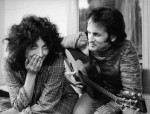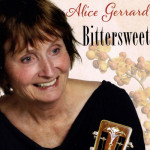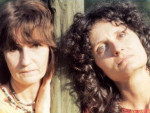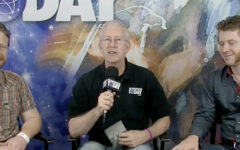
This profile of and interview with Alice Gerrard is a contribution from noted bluegrass songwriter, Louisa Branscomb, who also reviewed Gerrard’s current release, Bittersweet, for Bluegrass Today. You can find out more about her music and songwriting clinics online.
What’s the Kitchen Got to Do with It?
 It might seem unlikely: a childhood filled with the inspired music of a classically informed mother and father, followed by the personal evolution to a historic role in the heritage of American roots music. But that’s where the kitchen comes in.
It might seem unlikely: a childhood filled with the inspired music of a classically informed mother and father, followed by the personal evolution to a historic role in the heritage of American roots music. But that’s where the kitchen comes in.
“My mother was classically trained, but she could play anything on piano by ear, and my father sang with her. But for them music was not about formal classical music. It was about gathering with friends in your own home and sharing music until the early morning hours. Music was about improvisation, laughter, and friends. I learned early on that you could do it yourself, and that it’s natural for music to be created and shared right in your own home.”
So Alice Gerrard left home with music, in her words, “inside me,” and found herself in the middle of the folk cultural movement of the late ’50s and ’60s. “I always loved the fiddle and banjo,” she explained, “and when I got to college, I looked around and people had beards and Birkenstocks and guitars. I knew I had found my place.”
From then until now, Alice has logged many musical miles into a soul that, judging by her songs, was deep to start with. After several years in college, she moved to Washington, DC, a mecca for the blending of acoustic traditions in the ’60s.
Back then, as bluegrass was newly defining itself, Alice reflects that there was less distinction between bluegrass and old time. Bluegrass players in the DC area, such as Pete Kuykendall, listened to a variety of music including old time greats. Some of the first bluegrass bands had fiddle players straight out of the old time fiddle tradition. “After all,” Alice jokes, “Uncle Pen was an old time fiddler!”
 Playing all day and most nights, Alice was immersed in the acoustic music of the ’60s and ’70s, and exposed to folk icons such as Guy Carawan, Peggy Seeger, Mike Seeger, the Carter family, and, as most folks know, her long time singing partner Hazel Dickens. “In my way of thinking,” she explains, “all these strands of traditional music are woven together. Somehow, a kind of separatism between bluegrass and folk music arose, but I see them as interconnected from the start. It’s good to see some of the younger bluegrass musicians learning about the heritage in roots and old time music. I think it is important not to lose the soul of the music to technical wizardry – and for young musicians to really explore where bluegrass comes from. That forms a stronger foundation for the authenticity of the music.”
Playing all day and most nights, Alice was immersed in the acoustic music of the ’60s and ’70s, and exposed to folk icons such as Guy Carawan, Peggy Seeger, Mike Seeger, the Carter family, and, as most folks know, her long time singing partner Hazel Dickens. “In my way of thinking,” she explains, “all these strands of traditional music are woven together. Somehow, a kind of separatism between bluegrass and folk music arose, but I see them as interconnected from the start. It’s good to see some of the younger bluegrass musicians learning about the heritage in roots and old time music. I think it is important not to lose the soul of the music to technical wizardry – and for young musicians to really explore where bluegrass comes from. That forms a stronger foundation for the authenticity of the music.”
Alice herself doesn’t see her own music in a category, which is true of most noteworthy songwriters. “I loved blues, jazz, some of the pop and rock of those times. At the same time I loved old time. I also tend to love anything a little different.” For example, she cites, Rosemary Clooney, who recorded a song called Come On-a My House, with a harpsichord. “I loved that because it was different.”
 This musical flexibility and ease is apparent on listening to her new CD, Bittersweet. Produced by Laurie Lewis and presenting a cast of musicians who can cross any stylistic boundary without a blink, the songs on Bittersweet flow effortlessly from threads of country to bluegrass to the plaintive haunting a cappella ballad. It is the hallmark of a songwriter with a great depth of personal experience that his or her compositions are simply good songs, often amenable to different stylistic interpretations. “If you have the imagination and if you love songs and working with them, you’ll find a way to put it into a song that is meaningful to you,” she says, in her straightforward way of summing things up. She observed that it is the public, and retailers – whether in record bins or online bios – who need to classify music by genre. Alice admits that she probably fits best into the evolving category called “Americana,” which honors a variety of acoustic traditions.
This musical flexibility and ease is apparent on listening to her new CD, Bittersweet. Produced by Laurie Lewis and presenting a cast of musicians who can cross any stylistic boundary without a blink, the songs on Bittersweet flow effortlessly from threads of country to bluegrass to the plaintive haunting a cappella ballad. It is the hallmark of a songwriter with a great depth of personal experience that his or her compositions are simply good songs, often amenable to different stylistic interpretations. “If you have the imagination and if you love songs and working with them, you’ll find a way to put it into a song that is meaningful to you,” she says, in her straightforward way of summing things up. She observed that it is the public, and retailers – whether in record bins or online bios – who need to classify music by genre. Alice admits that she probably fits best into the evolving category called “Americana,” which honors a variety of acoustic traditions.
As a musician also influenced by the counterculture music of the ’60s, I pressed Alice to comment on the era of “true folk,” when many songs were intended to send a political message. Frequently the intent of the song was to shed light on the plight of the common person adversely affected by political or social circumstances beyond their control. I observed that political message songs seem unpopular of late, and wondered about her thoughts on how playing music in the heyday of social activism affected her as an artist and songwriter.
In response, Alice cited the groundbreaking musical tour that came to be known as the Southern Folk Cultural Revival Project, Inc. [1] While black and white roots-based singers and songwriters were brought to the Northeast to perform concurrently in the Northeast, she noted that in early folk days this was very uncommon in the South. This led her friends Ann Romaine, from Gastonia, NC, and Bernice Reagon, social activist and founder of the group Sweet Honey in the Rock, to join forces to bring powerful roots singers from different traditions together to tour throughout the Appalachians and Deep South. The intent was to twofold: to make a political statement about civil rights and human rights, and to bring grass roots music to the very culture from which it evolved.
“We didn’t make much money,” she reflected, “but traveling together in a beat-up van with powerful musical giants such as Ola Belle Reed, Dock Boggs, and others was a big part of my evolution as a person, musician, and songwriter. The tour itself – on the face of it – made a statement. Then you had people like Roscoe Holcomb, whose life was living in an area in Eastern Kentucky ravaged by strip mining – his life is a political statement.”
 Alice believes this experience gave Hazel Dickens, whose life also reflected Appalachian hardship, permission to speak out and write songs about controversial social topics and the realities of her own life. For Alice herself, it opened her eyes to the realm of individual differences between people and the possibilities of music to join people together, inform others about human experience, and transcend barriers.
Alice believes this experience gave Hazel Dickens, whose life also reflected Appalachian hardship, permission to speak out and write songs about controversial social topics and the realities of her own life. For Alice herself, it opened her eyes to the realm of individual differences between people and the possibilities of music to join people together, inform others about human experience, and transcend barriers.
With this rich heritage, one might think Alice carries an axe to grind about – well, something – but she is far more sweet than bitter, with one exception: “I’ve always leaned toward the dark side of the music – the melancholy side of bluegrass and folk.” This said, her music has evolved into the simple magic of traditional songs about common people that flow effortlessly with unpretentious grace. No surprise, then, that Bittersweet has just recently achieved the #1 position on the Folk DJ Chart.
Time passed while Alice and I covered topics from folk heritage to songwriter experiences to the acoustic benefits of kitchens over living rooms. Meanwhile, I found that as a songwriter conducting the interview, I kept looking for the hook — some catchy phrase or provocative quote on which to hang the story of Alice Gerrard. But Alice dodged my set-ups and metaphors until I realized: that’s the point. Here you have a founding figure in the folk tradition, with distinctions including covers by artists including Kathy Mattea, a successful recent tour combining her compositions with Lee Smith’s book, On Agate Hill, a collaborative project with Mike Seeger that was one of his last, and a Lifetime Achievement Award from the International Bluegrass Music Association. Yet to talk to her, you’d think she’s as laid back and regular as the person next door. So, when asked about her eye to the future, she was predictably down to earth: “Well, after raising four kids and working for 23 years on the magazine, [2] I’m finally in a position to tour and record. So what do I do? I go get a rescue dog who needs me at home! What’s up with that?”
My guess… what’s up with that is the kitchen. She’s excited about an upcoming tour to Spain with performing colleague Beverly Smith. But she admits that she does not have a hole that she feels driven to fill with playing or recording. Bittersweet, in fact, was largely a result of prodding by producting visionary Laurie Lewis, with encouragement from musician friends Cathy Fink and Laurelynn Dossett along the way. So although Alice loves the traveling, performing, and playing for others, she does not have a driving need to promote herself through touring or recording. Instead, she loves music in the context we all share in roots music – making good music with friends at home around the table. Indeed, it’s more than a past time. It’s the very heritage that defines every form of traditional American music, from old time fiddle tunes from the moors of Scotland to a bluegrass song written last night.
So I’m pretty sure she would welcome a few weeks off from her busy schedule to hang out in the kitchen with Polly the high-maintenance rescue dog and a few friends, simply playing good music. Just like it all started.
1.For more on the Southern Folk Cultural Revival Project and Alice’s historic collections, consult Alice’s web site. Many of her tapes and field recordings are archived in the UNC Chapel Hill Southern Folklife Collection.
2. The Old-Time Herald, which Alice started in 1987 in Galax, Virginia, and which continues today. Alice began the magazine in the basement of a friend’s store during her eight years playing music in the Galax, Virginia area.







